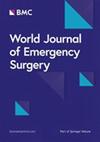Clinical outcomes of rib fracture stabilization and conservative treatment in a high-volume Asian trauma center: a propensity score-matched retrospective study
IF 5.8
1区 医学
Q1 EMERGENCY MEDICINE
引用次数: 0
Abstract
Rib fractures are common chest wall injuries with conservative treatment and surgical stabilization of rib fractures (SSRF) as treatment options. We retrospectively compared the efficacy and long-term prognosis of conservative treatment and SSRF as treatment options for rib fractures. This retrospective study was conducted at a single trauma center in Taiwan. The study population comprised patients with rib fractures who underwent conservative treatment or SSRF at the National Taiwan University Hospital between 2017 and 2022. We analyzed the outcomes between the operative and non-operative groups, including the length of intensive care unit and hospital stays, pain scales at admission and follow-up, and post-operative complication rates. Of the 217 patients with rib fractures in this study, 103 received SSRF, and 114 received conservative treatment. Patients in the operative group had worse consciousness statuses and higher injury severity scores than those in the non-operative group. In addition, patients in the operative group had more preoperative chest complications than those in the non-operative group. Regarding outcomes and long-term prognoses, patients in the operative group had longer intensive care unit and hospital stays than those in the non-operative group; however, patients in the operative group had better recovery quality than those in the non-operative group. Our study showed that, in patients who meet the surgical indications, SSRF is an effective and safe way to relieve acute pain after thoracic injury and achieve better recovery and quality of life after surgical intervention.亚洲一个大容量创伤中心肋骨骨折稳定和保守治疗的临床结果:倾向评分匹配的回顾性研究
肋骨骨折是常见的胸壁损伤,保守治疗和肋骨骨折手术稳定(SSRF)是治疗选择。我们回顾性比较了保守治疗和SSRF治疗肋骨骨折的疗效和长期预后。本研究在台湾单一创伤中心进行。研究人群包括2017年至2022年间在国立台湾大学医院接受保守治疗或SSRF的肋骨骨折患者。我们分析了手术组和非手术组之间的结果,包括重症监护病房和住院时间,入院和随访时的疼痛量表,以及术后并发症发生率。在本研究的217例肋骨骨折患者中,103例接受SSRF治疗,114例接受保守治疗。手术组患者意识状态差,损伤严重程度评分高于非手术组。此外,手术组患者术前胸部并发症发生率高于非手术组。关于结局和长期预后,手术组患者的重症监护病房和住院时间比非手术组更长;但手术组患者恢复质量优于非手术组。我们的研究表明,在符合手术指征的患者中,SSRF是一种有效且安全的方法,可以缓解胸椎损伤后的急性疼痛,并在手术干预后获得更好的恢复和生活质量。
本文章由计算机程序翻译,如有差异,请以英文原文为准。
求助全文
约1分钟内获得全文
求助全文
来源期刊

World Journal of Emergency Surgery
EMERGENCY MEDICINE-SURGERY
CiteScore
14.50
自引率
5.00%
发文量
60
审稿时长
10 weeks
期刊介绍:
The World Journal of Emergency Surgery is an open access, peer-reviewed journal covering all facets of clinical and basic research in traumatic and non-traumatic emergency surgery and related fields. Topics include emergency surgery, acute care surgery, trauma surgery, intensive care, trauma management, and resuscitation, among others.
 求助内容:
求助内容: 应助结果提醒方式:
应助结果提醒方式:


